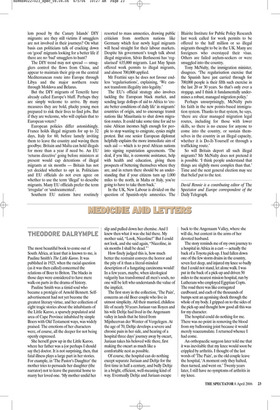The most beautiful book to come out of South Africa,
at least that is known to me, is Pauline Smith’s The Little Karoo. It was published in 1925, when the racial question (as it was then called) concerned the relations of Boer to Briton. The blacks in those days were considered to have mere walk-on parts in the drama of history.
Pauline Smith was a timid soul who became a protégée of Arnold Bennett. Selfadvertisement had not yet become the greatest literary virtue, and her collection of eight tragic stories about the inhabitants of the Little Karoo, a sparsely populated arid area of Cape Province inhabited by simple Boers with Old Testament ways, was widely praised. The emotions of her characters were, of course, all the deeper for not being openly expressed.
She herself grew up in the Little Karoo, where her father was a (or perhaps I should say the) doctor. It is not surprising, then, that fatal illness plays a large part in her stories. For example, in ‘The Pastor’s Daughter’ the mother tries to persuade her daughter (the narrator) not to leave the parental home to marry her loved one. ‘My mother undid her slip and pulled down her chemise. And I knew then what it was she hid there. My mother said, “Look, Niccoline!” But I could not look, and she said again, “Niccoline, in six months I shall be dead.”’ How finely judged this is, how much better the restraint conveys the horror and the pity of it than a literal-minded description of a fungating carcinoma would! In a few years, maybe, when ideological vulgarity has transformed all men’s souls, no one will be left who understands the value of the implicit.
The first story in the collection, ‘The Pain’, concerns an old Boer couple who live in utmost simplicity. All their married, childless life of nearly 50 years Juriaan van Royen and his wife Deltje had lived in the Angenaam valley in lands that he hired from Mijnheervan der Wenter of Vergelegen. At the age of 70, Deltje develops a severe and chronic pain in her side, and hearing of a hospital three days’ journey away by oxcart, Juriaan takes his beloved wife there, first making the oxcart as much like a comfortable nest as possible.
Of course, the hospital can do nothing except separate Juriaan and Deltje for the first time in half a century, and bully Deltje in a bright, efficient, well-meaning kind of way. Eventually Deltje and Juriaan escape back to the Angenaam Valley, where she will die, but content in the arms of her devoted husband.
The story reminds me of my own journey to a hospital in Africa in a cart — actually the back of a Toyota pick-up. I had fallen down one of the few storm drains in the country, seven feet deep, and injured my knee so badly that I could not stand, let alone walk. I was put in the back of a pick-up and driven 50 miles to the nearest mission hospital, run by Lutherans who employed Egyptian Copts. The road there was like corrugated cardboard, and each of the thousands of bumps sent an agonising shock through the whole of my body. I gripped on to the sides of the pick-up and thought how good all this was for my character.
The hospital could do nothing for me. There was no point in removing the blood from my ballooning joint because it would merely reaccumulate. I returned whence I had come.
An orthopaedic surgeon later told me that it was inevitable that my knee would soon be crippled by arthritis. I thought of the last words of ‘The Pain’, as the old couple leave the hospital, ‘A moment only they halted, then turned, and went on.’ Twenty years later, I still have no symptoms of arthritis in my knee.










































































 Previous page
Previous page